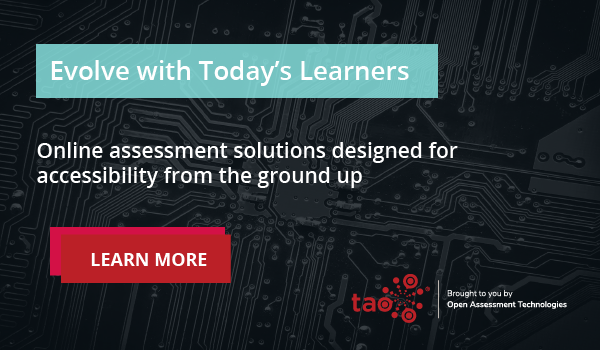In today’s education landscape equity should be at the forefront of all school, school district, and state-level policy decisions. Developing an equitable learning experience and curriculum provides high-quality education and opportunities for growth for all students. Nowhere is this more true than when creating and implementing assessments.
Equity in assessment, especially in digital assessment, centers around utilizing tools that are accessible and inclusive in design and give students multiple opportunities to engage with materials. By designing assessments in a manner that reduces bias as much as possible, while also enabling all students to access and engage with the material, teachers can create a more equitable classroom.
Equity in Assessment Matters
Learning equity has always mattered, yet since the pandemic cast such a harsh light on the inequalities in education taking place — not only globally but also from state to state, district to district, and household to household — teachers and education leaders have been placing a greater focus on closing the digital divide and ensuring inclusivity. Improving equity in assessment helps students to learn more and do their best in school, it also helps to ensure that students are not inadvertently left behind. Beyond the classroom, developing equitable assessments is important for both legal and ethical reasons.
Ethically
Schools are charged with educating students, regardless of race, gender, socio-economic background, and cognitive or physical abilities. Developing more equitable assessments is simply the right thing to do for these students.
This means taking a look at how we traditionally assess students and how this may increase the gaps in student learning. By doing this teachers can identify any bias and implement strategies that better support student engagement and learning, which in the end will help all students to be more successful in life.
Legally
Not only is creating equity in assessment morally grounded, but it is also legally required in many cases, particularly in the United States when it comes to special education. Many students with special needs, either cognitively, behaviorally, or physically, have an IEP or 504 plan that dictates supports that need to be put in place to create an equitable learning environment.
Students with different ethnic or religious backgrounds also have legal protections that prevent discrimination and bias, including in testing and assessment. Standardized assessment in the United States has a history of exacerbating racism and discrimination by using data from inherently biased tests. By building assessments with equity in mind, teachers get a better picture of what their students can do while simultaneously reducing bias and discrimination.
Where are the Gaps?
Many areas could be identified as gaps in equity concerning student learning. However, the largest gaps occur in the following populations of students:
- English Language Learners – students that are just learning English can struggle to access materials designed for English-speaking peers.
- Students experiencing poverty or homelessness – for these students, a school may simply be a safe place to pass the day. Typically these students experience higher mobility and may attend many schools over the course of a year making it difficult to provide a cohesive educational experience leading to enlarged gaps in learning.
- Students with mental health concerns – ADHD, autism, anxiety, and depression, among others, can make it difficult for students to learn at the same pace as their peers. Often a class will move forward with content before students with mental health concerns are ready to do so, creating a gap in learning.
Equity and Diverse Learners
Developing equity in assessments and lessons is a challenge. This is especially true for classrooms where you may have students with disabilities, language learners, wealthy students, students from poverty, and gifted students, all sitting in the same room learning the same content. It can feel impossible to meet all of these students’ needs at one time. However, there are options for differentiation that can improve equity in student learning and reduce gaps in student achievement.
By utilizing and implementing Universal Design for Learning principles, which give students multiple opportunities to learn content and engage with lessons in different ways, we can meet students where they are at. This pushes gifted and talented students while, at the same time, enabling students with special needs and language learners to access and thrive within the same curriculum. In essence, new technology platforms give teachers the ability to individualize their learning and engage more fully in the curriculum, which provides a more equitable learning experience for students.
How to Build Equity into Assessment
With so many new education-based platforms and digital tools available to teachers, schools and districts must keep student equity top of mind when looking at implementing digital assessment.
For one, schools should choose tools that approach accessibility from the ground up, rather than technology that is retrofitted after the fact. Using an assessment system that follows Universal Design principles is a good place to start. Universal Design dictates that students have multiple ways to show learning and multiple ways of engaging with the lesson. For example, a system based on Universal Design is designed to be read by screen readers, incorporates accessibility controls like keyboard navigation, makes use of clear navigation, etc.
Universal Design can also be applied when building the assessments themselves. This means going outside of traditional testing and embracing new ways of assessment such as performance-based assessments or leveraging game-like simulations to better assess students and determine what they can do.
Outside of Universal Design, it is also important to think of the delivery and logistics around assessments. Resources within the assessment like PDFs or other media need to be designed for accessibility. This means that PDFs need heading structures, videos need media captions, and images need alternate text so that students can access them regardless of their vision capabilities. With all of this in mind, we also need to make sure that educators are trained to use this technology and that it isn’t an afterthought in their lessons. And beyond the classroom, it is also important to remember that equity is also about access to the internet and software packages that enable all students to use the technology.
Open Assessment Technologies offers a full suite of assessment tools for use in and out of the classroom. If your school or school district would like to learn more about how OAT can deliver high-quality, equitable assessment to students, click here.


